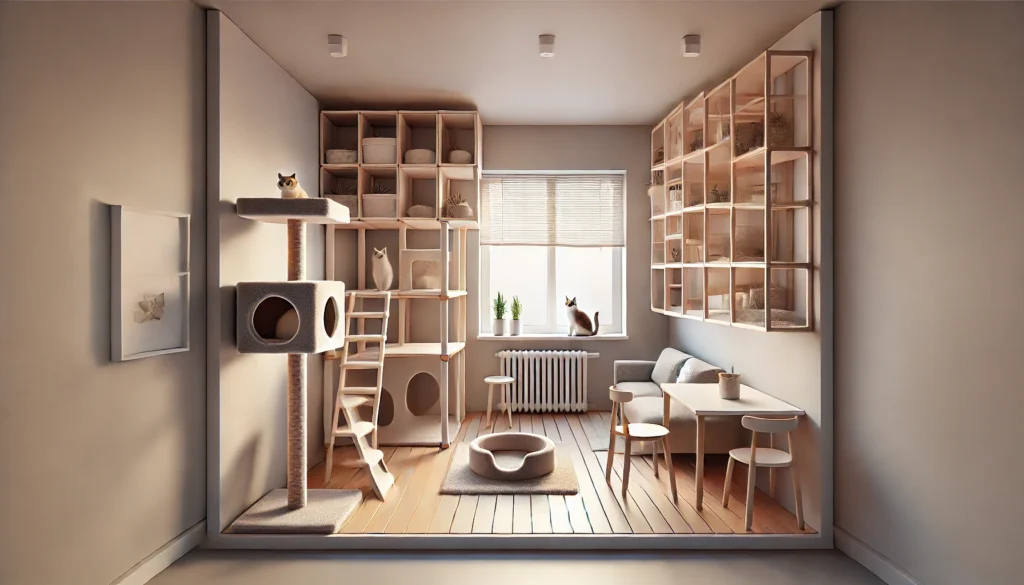Cats love to climb, perch, scratch, and play — but living in a small home or apartment can make it challenging to provide enough stimulation and territory. The good news? You don’t need a lot of square footage to build a fully enriching, multi-level indoor playground for your feline friend.
With smart vertical planning and a few creative setups, you can give your cat the mental and physical engagement they crave — even in the smallest spaces.
Why Cats Thrive With Multi-Level Environments
Cats are vertical creatures by nature. A well-designed, multi-level space allows them to:
- Observe their surroundings from above
- Claim territory and escape floor-level stress
- Exercise by jumping and climbing
- Engage in daily play and exploration
- Reduce boredom, especially in indoor-only lifestyles
When you add levels, you expand your cat’s world — without taking up extra room.
Planning Your Cat’s Vertical Playground
Even in a studio or compact apartment, look for vertical “real estate.” Start by identifying:
- Empty wall space
- Corners near windows
- Tops of furniture
- Unused shelf space
- Spaces above doors or appliances
Then, combine multiple elements to form a connected experience with variety in texture, purpose, and height.
Essential Components of a Vertical Cat Playground
1. Wall-Mounted Shelves
- Create stair-step patterns or zigzags
- Use carpeted or textured surfaces for grip
- Place near furniture for easy access
2. Cat Trees or Towers
- Choose slim, vertical styles for small rooms
- Place near windows for sunbathing and viewing
- Add hanging toys or hideouts on different levels
3. Window Perches
- Suction-cup hammocks or shelf-mounted perches
- Offer both sunlight and entertainment
- Can be positioned above heaters in winter
4. Floating Boxes or Nesting Spots
- Use wall-mounted boxes or hammocks for cozy hideaways
- Line with soft blankets or scratchable material
- Combine with shelves to form elevated “routes”
5. Overhead Bridges or Beams
- Fabric or wooden walkways across rooms
- Only for confident, agile cats
- Install securely with anchors and supports
Smart DIY Solutions for Small Homes
You don’t need custom carpentry to build your playground. Here are easy, renter-friendly options:
- Bookshelf Hacks: Clear a shelf or two for your cat, line with carpet, and anchor for safety
- Corner Wall Shelves: Add triangular corner shelves for climbing in tight spaces
- IKEA Hacks: Use LACK shelves, spice racks, or modular cube storage
- Over-the-Door Cat Hammocks: Add levels on doors with removable hardware
- Stacked Storage Bins: Create stair-like steps using stable storage cubes or containers
Make sure all surfaces are stable, secure, and accessible with a safe path up and down.
Building in Layers: A Sample Layout
Base Level:
- Scratching post
- Food and water area (separate from litter)
- Tunnel or play mat
Mid-Level:
- Cat tree with platforms
- Bookshelf perch
- Hideout or cubby
High Level:
- Window perch
- Top of a cabinet or closet
- Wall-mounted shelf
Connect them through ramps, jumping points, or cat-safe furniture. Allow resting spots at each level for variety.
Keeping It Stimulating
Rotate toys and add novelty to keep the space engaging.
- Hang teaser wands or toys from perches
- Sprinkle catnip or silvervine on shelves weekly
- Change bedding or add boxes to create fresh hideouts
- Use puzzle feeders or treat-dispensing toys on different levels
Challenge their curiosity with new smells, textures, and objects.
Managing Safety and Accessibility
Even active cats need safe, accessible climbing options.
- Use soft landing areas below tall spots
- Avoid unstable surfaces or narrow ledges
- For senior cats, use ramps or lower step height
- Keep all paths clear of clutter
Supervise early exploration, especially with wall-mounted or high-up elements.
Adapting for Multi-Cat Homes
Multi-level structures help reduce tension between cats by offering:
- Separate vertical zones
- Choice in resting spots
- Escape routes and observation points
Make sure each cat has space to retreat and rotate use of high-value locations (like the window perch) with scent swapping or separate routines.
Cleaning and Maintenance
- Wipe down shelves weekly
- Vacuum trees and soft furnishings to remove fur
- Check for loose bolts, anchors, or wobbling
- Replace worn toys and scratched surfaces regularly
Keeping the area fresh makes it more appealing for your cat — and keeps your home tidy.
A Playground That Grows With Your Cat
Start small and expand your cat’s vertical playground over time. You might begin with a wall perch and scratching post, and later add bridges, shelves, and cozy high-up zones as your space allows.
Your cat will naturally begin using the structures in their own way — resting high, watching birds, sprinting up trees, or curling into hideouts.
The best part? It’s enriching, healthy, and completely possible — no matter how small your space may be.






